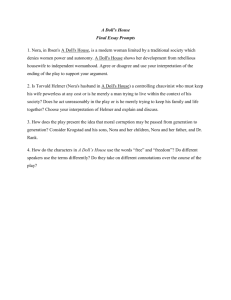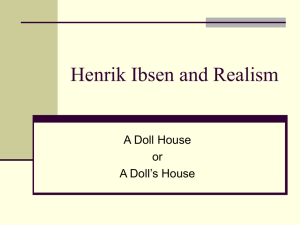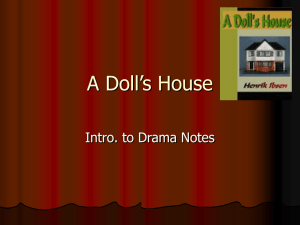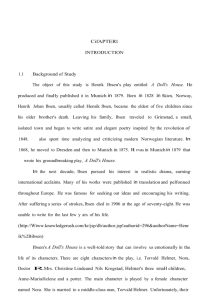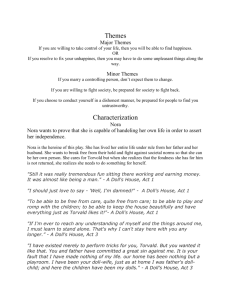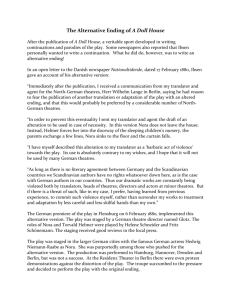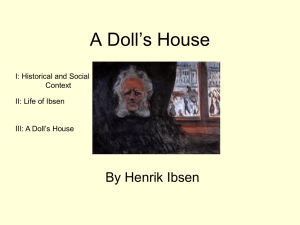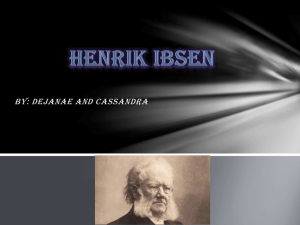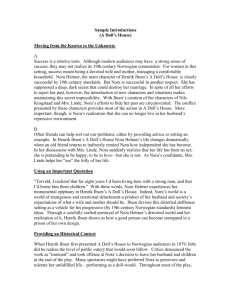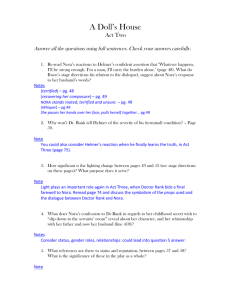Week 8 A Doll`s House - University of Warwick
advertisement
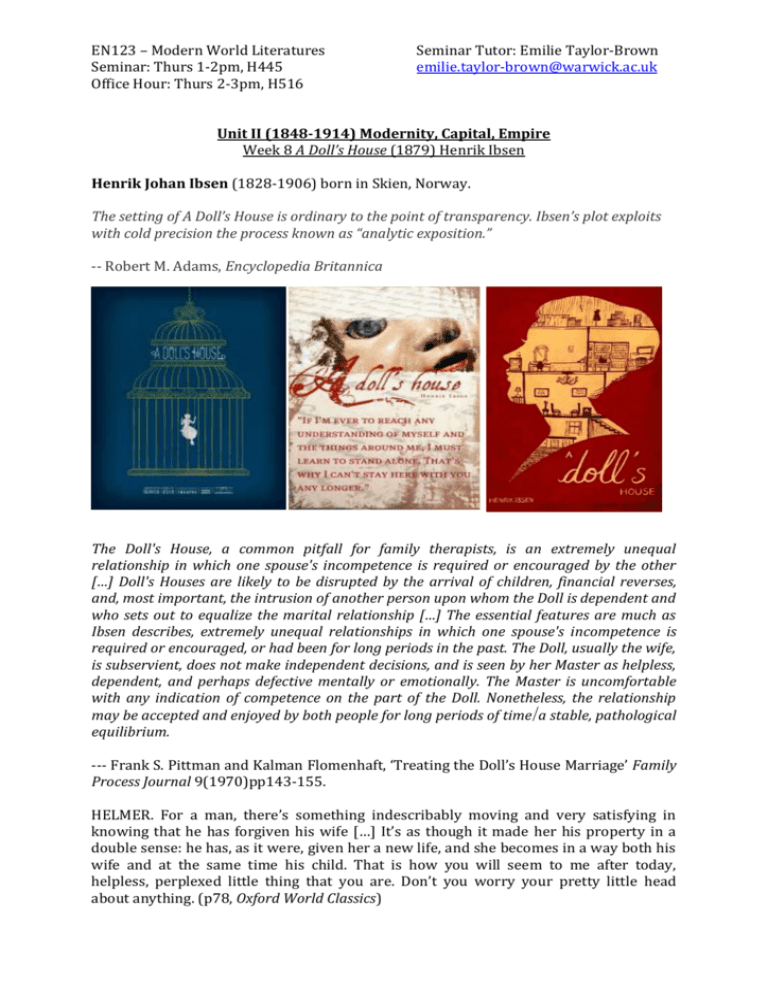
EN123 – Modern World Literatures Seminar: Thurs 1-2pm, H445 Office Hour: Thurs 2-3pm, H516 Seminar Tutor: Emilie Taylor-Brown emilie.taylor-brown@warwick.ac.uk Unit II (1848-1914) Modernity, Capital, Empire Week 8 A Doll’s House (1879) Henrik Ibsen Henrik Johan Ibsen (1828-1906) born in Skien, Norway. The setting of A Doll’s House is ordinary to the point of transparency. Ibsen’s plot exploits with cold precision the process known as “analytic exposition.” -- Robert M. Adams, Encyclopedia Britannica The Doll's House, a common pitfall for family therapists, is an extremely unequal relationship in which one spouse's incompetence is required or encouraged by the other […] Doll's Houses are likely to be disrupted by the arrival of children, financial reverses, and, most important, the intrusion of another person upon whom the Doll is dependent and who sets out to equalize the marital relationship […] The essential features are much as Ibsen describes, extremely unequal relationships in which one spouse's incompetence is required or encouraged, or had been for long periods in the past. The Doll, usually the wife, is subservient, does not make independent decisions, and is seen by her Master as helpless, dependent, and perhaps defective mentally or emotionally. The Master is uncomfortable with any indication of competence on the part of the Doll. Nonetheless, the relationship may be accepted and enjoyed by both people for long periods of time a stable, pathological equilibrium. --- Frank S. Pittman and Kalman Flomenhaft, ‘Treating the Doll’s House Marriage’ Family Process Journal 9(1970)pp143-155. HELMER. For a man, there’s something indescribably moving and very satisfying in knowing that he has forgiven his wife […] It’s as though it made her his property in a double sense: he has, as it were, given her a new life, and she becomes in a way both his wife and at the same time his child. That is how you will seem to me after today, helpless, perplexed little thing that you are. Don’t you worry your pretty little head about anything. (p78, Oxford World Classics) EN123 – Modern World Literatures Seminar: Thurs 1-2pm, H445 Office Hour: Thurs 2-3pm, H516 Seminar Tutor: Emilie Taylor-Brown emilie.taylor-brown@warwick.ac.uk HELMER. A fog of lies like that in a household, and it spreads disease and infection to every part of it. Every breath the children take in that kind of home is reeking with evil germs. […] HELMER. …as a lawyer I know what I’m talking about. Practically all juvenile delinquents come from homes where the mother is dishonest. NORA. Why mothers particularly? HELMER. It’s generally traceable to the mothers, but of course fathers can have the same influence […] Krogstad [has] been poisoning his own children for years with lies and deceit. That’s the reason I call him morally depraved […] I quite literally feel physically sick in the presence of such people. […] NORA. [Pale with terror] Corrupt my children. . . ! Poison my home? (pp33-34) NORA. [Doctor Rank has] got something terribly wrong with him, you know. Tuberculosis of the spine, poor fellow. His father was a horrible man, who used to have mistresses and things like that. That’s why the son was always ailing, right from being a child. MRS LINDE. [lowering my sewing] But my dear Nora, how do you come to know about things like that? NORA. [walking about the room] Huh! When you’ve got three children, you get visits from . . . women who have had a certain amount of medical training. And you hear all sorts of things from them. (pp37-38) The problem of A Doll’s House is not concerned with the marriage relations of Nora and Helmer, but with the character of Nora […] she is charming and dishonest, always flitting, never resting, a light-headed, light-hearted, inconsequential thing. A deeper note sounds in the music and the reader is startled by the revelation that this flippant creature has been carrying for years a secret and a burden that would have wrecked a heavier nature. The character is improbable, impossible; yet something in the telling of it holds one to a sense of reality […] she is to dance the tarantella, the Neapolitan dance that her husband has taught her. She is eager to dance it well for his sake and for her own. The tarantella is the play. -- Jennette Lee, ‘An Illustration of Symbolism: “A Doll’s House”’ The Ibsen Secret: A Key to the Prose Dramas of Henrik Ibsen [1907] (Honolulu: University Press of the Pacific, 2001) pp11-13. The Tarantella – a dance of Southern Italy written in 6/8 time. The tarantella’s origin is connected with tarantism, a disease or form of hysteria that appeared in Italy in the 15th to the 17th century and that was obscurely associated with the bite of the tarantula spider; victims seemingly were cured by frenzied dancing -- Encyclopedia Britannica EN123 – Modern World Literatures Seminar: Thurs 1-2pm, H445 Office Hour: Thurs 2-3pm, H516 Seminar Tutor: Emilie Taylor-Brown emilie.taylor-brown@warwick.ac.uk Points to Consider - What is the significance of the Christmas Tree/Tarantella/Macaroons/Skylarks/Dr. Rank’s Illness/Helmer’s study? - What part does Mrs. Linde play in the drama? - Why does Ibsen’s write in Dr. Rank’s feelings and why are they revealed? - How does Nora approach parenting? - How does the staging of the rooms affect the dynamics of the play? - What is the significance of the letterbox? - What is the connection between morality and disease? [NB. Research: Miasmatism versus Contagionism; think about heredity and environment] Further Reading Brian Johnson, ‘The Dangerous Seduction of the Past: Ibsen’s Counter-Discourse to Modernity’ Modernism in European Drama: Ibsen, Strindberg, Pirandello, Beckett: Essays eds. Frederick J. Marker and Christopher Innes (Toronto: University of Toronto Press, 1998) pp3-18. Jennette Lee, ‘An Illustration of Symbolism: “A Doll’s House”’ The Ibsen Secret: A Key to the Prose Dramas of Henrik Ibsen [1907] (Honolulu: University Press of the Pacific, 2001)
